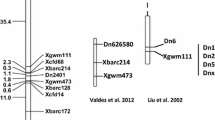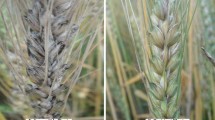Abstract
The Russian wheat aphid, Diuraphis noxia (Mordvilko), is a major pest of cereal crops in many areas of the world, causing serious reduction in grain yield in wheat (Triticum aestivum L.) and barley (Hordeum vulgare L.). Incorporating genetic resistance to D. noxia into wheat cultivars is paramount to effectively reduce damage inflicted by this pest. Genetic resistance to D. noxia has been identified in wheat, barley and rye germplasm, and several resistance genes are available for use for cultivar improvement. In the United States of America, only a few Russian wheat aphid (RWA) resistant winter wheat cultivars are currently available, and these cultivars contain only one of the six known RWA resistance genes. The objective of this study was to determine the inheritance of RWA resistance in wheat accession PI 47545, using a screening method based on differences in the leaf morphology of resistant and susceptible types following insect challenge. PI 47545 was selected for study, since it displayed high levels of resistance in a white-grained wheat background, the predominant wheat class produced in the Pacific Northwest of the USA. Segregation analysis was conducted on an F2 population developed by cross-hybridizing the susceptible soft white winter wheat cultivar ‘Daws’ to the resistant accession PI 47545. Russian wheat aphid screening data from this population indicated that the resistance in PI 47545 is controlled by a single, dominant gene (χ2 = 1.72; p ≤ 0.189).
Similar content being viewed by others
References
Anonymous,1989. Economic Impact of the Russian Wheat Aphid in the Western United States:1987–1988. Great Plains Agric Counc Publ 29, Fort Collins, Colorado, USA.
Anonymous, 1997.Guidelines for Small Grain Production in the Summer Rainfall Region. Small Grain Institute, Agricultural Research Council, South Africa.
Du Toit, F., 1987. Resistance in wheat (Triticum aestivum) to Diuraphis noxia (Homoptera:Aphididae). Cereal Res Commun 15: 175–179.
Du Toit, F., 1988. Another source of Russian wheat aphid(Diuraphis noxia) resistance in Triticum aestivum. Cereal Res Commun 16: 105–106.
Du Toit, F., 1989.Inheritance of resistance in two Triticum aestivum lines to Russian wheat aphid (Homoptera: Aphididae). J Econ Entomol 82: 1251–1253.
Du Toit, F., W.G. Wessel & G.F. Marais, 1995. The chromosome arm location of theRussian wheat aphid resistance gene, Dn5. Cereal Res Commun 23: 15–17.
Elsidaig, A.A. & P.K. Zwer,1993. Genes for resistance to Russian wheat aphid in PI 294994 wheat. Crop Sci 33: 998–1001.
Fouche, A.,R.L. Vehoeven, P.H. Hewitt, M.C. Walters, C.F. Kriel & J. De Jager, 1984. Russian wheat aphid (Diuraphis noxia) feeding damage on wheat, related cereal and a Bromus grass species. In: M.C. Walters (Ed.), Progress in Russian Wheat Aphid (Diuraphis noxia Mordv.) Research in the Republic of South Africa, pp 22–33. S Afr Dep Agric Tech Commun 191.
Gilchrist, L.I.,R. Rodriguez-Montessoro & P.A. Burnett, 1986. The toxemia caused by Diuraphis noxia and its importance as a vector of plant virus in Mexico. Agrociencia 66: 141–153.
Grossheim, N.A., 1914.Brachycolus noxia. Memoirs of the Natural-History Museum of the Zemstvo of Government of Taurida, Simferopol iii, pp 35–78. (Rev Appl Entomol Ser A 1915 3: 307–308).
Harvey, T.L. & T.J. Martin, 1990. Relative coldtolerance of Russian wheat aphid and biotype-E greenbug (Homoptera: Aphididae). Cereal Res Commun 18: 127–129.
Jones, J.W., J.R. Byers, R.A. Butts & J.L. Harris, 1989. A new pest in Canada: Russian wheat aphid, Diuraphisnoxia (Mordvilko) (Hompotera: Aphididae). Can Entomol 121: 623–624.
Legg, A. & S. Amosson, 1993.Economic impact of the Russian wheat aphid in the western United States: 1991–1992. Great Plains Agric Council Publ No. 147.
Marais, G.F. & F. Du Toit, 1993. A monosomic analysis of Russian wheat aphid resistance in the commonwheat PI 294994. Plant Breed 111: 246–248.
Nkongolo, K.K., J.S. Quick, W.L. Meyer & F.B. Peairs,1989. Russian wheat aphid resistance of wheat, rye, and triticale in greenhouse tests. Cereal Res Commun 17: 227–232.
Nkongolo, K.K., J.S. Quick, A.E. Limin & D.B. Fowler, 1991a. Sources and inheritance of resistanceto Russian wheat aphid in Triticum species amphiploids and Triticum tauschii. Can J Plant Sci 71: 703–708.
Nkongolo, K.K., J.S. Quick, F.B. Peairs & W.L. Meyer, 1991b. Inheritance of resistance of PI 372129 wheat to theRussian wheat aphid. Crop Sci 31: 905–907.
Pankendorf, K.W., 1984. The research program for combatingthe Russian wheat aphid (Diuraphis noxia Mordvilko) in South Africa. In: Proc 2nd Intl Barley Yellow Dwarf Workshop, 6–8 December 1983, pp. 194–170. Intl Maize and Wheat Improvement Center, Mexico.
Peterson Jr., C.J.,O.A. Vogel, D.W. George, G.L. Rubenthaler & R.E. Allen, 1976. Registration of 'Daws' wheat. Crop Sci 17: 674–675.
Quick, J.S., G.E. Ellis, R.M. Mormann, J.A. Stromberger, J.F. Shanahan, F.B. Peairs, J.B. Rudolph & K. Lorenz, 1996. Registration of 'Halt' wheat. Crop Sci 36: 210.
Quisenberry, S.S. & D.J. Schotzko, 1994. Russian wheat aphid population development and plant damage on resistant and susceptible wheat. J Econ Entomol 87: 1761–1768.
Saudi, A. & J.S. Quick, 1996. Inheritance and allelic relationshipsamong Russian wheat aphid resistance genes in winter wheat. Crop Sci 36: 256–258.
SAS Institute, 1987. SASUser's Guide: Statistics. 6th ed. SAS Institute, Cary, N.C.
Schotzko, D.J. & C.M. Smith, 1991. Theeffects of preconditioning host plants on population development of the Russian wheat aphid (Homoptera: Aphididae)]. J Econ Entomol 84: 1083–1087.
Schroeder-Teeter, S., R.S. Zemetra, D.J. Schotzko, C.M. Smith & M. Rafi, 1994.Monosomic analysis of Russian wheat aphid (Di35 uraphis noxia resistance in Triticum aestivum line PI 137739. Euphytica 74: 117–120.
Semenov, P.V., 1984. Cereal aphids - Dangerous pests. Zashch Rast (Moscow) 10:42.
Smith, C.M., D.J. Schotzko, R.S. Zemetra, E.J. Souza & S. Schroeder-Teeter, 1991. Identification ofRussian wheat aphid resistance in wheat. J Econ Entomol 84: 328–332.
Smith, C.M., D.J. Schotzko, R.S. Zemetra & E.J. Souza, 1992. Categories of resistance in plant introduction of wheat resistant to the Russian wheat aphid (Homoptera: Aphididae). J Econ Entomol 85: 1480–1484.
Stoetzel, M.B., 1987. Information on andidentification of Diuraphis noxia and other aphid species colonizing leaves of wheat and barley in the United States. J Econ Entomol 80: 696–704.
Tolmay, V.L., D. van Hill & M.F. Smith, 1997. The influence of Demethon-S-Methyl/Parathion and Imidacloprid on the yield and quality of Russian wheat aphid resistant and susceptible wheat cultivars. S Afr J Plant & Soil. 14: 107–111.
Torres, E., 1984. Situation report: Eastern, Central and Southern Africa. In:Proc 2nd Intl Barley Yellow Dwarf Workshop, 6–8 December 1983, pp. 197. Intl Maize and Wheat Improvement Center, Mexico. Zadoks, J.C., T.T. Chang & C.F. Konzak, 1974. A decimal code for the growth stages of cereals. Weed Res 14: 415–421. Zemetra, R.S., D. Schotzko, C.M. Smith & E.J. Souza, 1990.Wheat resistant to the Russian wheat aphid. Cereal Res Commun 18: 223–227. Zerene, Z.M., D.M. Cagevic & A.I. Ramirez, 1988. A new cereal aphid detected in Chile. Agri Tech (Santiago) 48: 60–61. Zhang, Y., J.S. Quick & S. Liu, 1998. Genetic variation in PI 294994 wheat for resistance to Russian wheat aphid. Crop Sci 38: 527- 530.
Zadoks, J.C., T.T. Chang & C.F. Konzak, 1974. A decimal code for the growth stages of cereals. Weed Res 14: 415–421.
Zemetra, R.S., D. Schotzko, C.M. Smith & E.J. Souza, 1990. Wheat resistant to the Russian wheat aphid. Cereal Res Commun 18: 223–227.
Zerene, Z.M., D.M. Cagevic & A.I. Ramirez, 1988. A new cereal aphid detected in Chile. Agri Tech (Santiago) 48: 60–61.
Zhang, Y., J.S. Quick & S. Liu, 1998. Genetic variation in PI 294994 wheat for resistance to Russian wheat aphid. Crop Sci 38: 527–530.
Author information
Authors and Affiliations
Rights and permissions
About this article
Cite this article
Linscott, T., Bosque-Pérez, N., Schotzko, D. et al. Genetic control of Russian wheat aphid (Diuraphis noxia) resistance in wheat accession PI 47545. Euphytica 121, 31–35 (2001). https://doi.org/10.1023/A:1012003332713
Issue Date:
DOI: https://doi.org/10.1023/A:1012003332713




